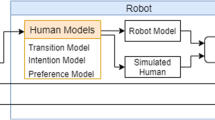Abstract
We claim that navigation in human environments can be viewed as cooperative activity especially in constrained situations. Humans concurrently aid and comply with each other while moving in a shared space. Cooperation helps pedestrians to efficiently reach their own goals and respect conventions such as the personal space of others. To meet human comparable efficiency, a robot needs to predict the human trajectories and plan its own trajectory correspondingly in the same shared space. In this work, we present a navigation planner that is able to plan such cooperative trajectories, simultaneously enforcing the robot’s kinematic constraints and avoiding other non-human dynamic obstacles. Using robust social constraints of projected time to a possible future collision, compatibility of human-robot motion direction, and proxemics, our planner is able to replicate human-like navigation behavior not only in open spaces but also in confined areas. Besides adapting the robot trajectory, the planner is also able to proactively propose co-navigation solutions by jointly computing human and robot trajectories within the same optimization framework. We demonstrate richness and performance of the cooperative planner with simulated and real world experiments on multiple interactive navigation scenarios.
Access this chapter
Tax calculation will be finalised at checkout
Purchases are for personal use only
Similar content being viewed by others
Notes
- 1.
- 2.
- 3.
- 4.
Source code for the cooperative planner is available at https://github.com/harmishhk/lateb_local_planner.
- 5.
- 6.
Although the motion capture system delivers data at higher frequency (about 100 Hz), we apply a moving average filter and re-sample the filtered data at 10 Hz to have better estimate of velocities.
References
Sebanz, N., Bekkering, H., Knoblich, G.: Joint action: bodies and minds moving together. Trends Cogn. Sci. 10(2), 70–76 (2006)
Lemaignan, S., Warnier, M., Sisbot, E.A., Clodic, A., Alami, R.: Artificial cognition for social human-robot interaction: an implementation. Artif. Intell. 247 (2017)
Waldhart, J., Gharbi, M., Alami, R.: Planning handovers involving humans and robots in constrained environment. In: International Conference on Intelligent Robots and Systems (2015)
Shah, J., Wiken, J., Williams, B.C., Breazeal, C.: Improved human-robot team performance using chaski, a human-inspired plan execution system. In: International Conference on Human-Robot Interaction, pp. 29–36 (2011)
Knoblich, G., Butterfill, S., Sebanz, N.: Psychological research on joint action. Psychol. Learn. Motiv. 54, 59–101 (2011)
Pacherie, E.: The phenomenology of joint action: self-agency vs. joint-agency. In: Axel, S. (ed.) Joint Attention: New Developments (2012)
Clodic, A., Alami, R., Chatila, R.: Key elements for human-robot joint action. Sociable Robots and the Future of Social Relations, vol. 273, pp. 23–33 (2014)
Tomasello, M., Carpenter, M., Call, J., Behne, T., Moll, H.: Understanding and sharing intentions: the origins of cultural cognition. Behav. Brain Sci. 28 (2005)
Bratman, M.E.: Shared intention. Ethics 104(1), 97–113 (1993)
Clark, H.H., Schreuder, R., Buttrick, S.: Common ground at the understanding of demonstrative reference. J. Verbal Learn. Verbal Behav. 22, pp. 245–258 (1983)
Watanabe, A., Ikeda, T., Morales, Y., Shinozawa, K., Miyashita, T., Hagita, N.: Communicating robotic navigational intentions. In: International Conference on Intelligent Robots and Systems, pp. 5763–5769 (2015)
Hall, E.T.: The Hidden Dimension: Man’s Use of Space in Public and Private (1966)
Rios-Martinez, J., Spalanzani, A., Laugier, C.: From proxemics theory to socially-aware navigation: a survey. Int. J. Soc. Robot. 7(2), 137–153 (2014)
Kruse, T., Pandey, A.K., Alami, R., Kirsch, A.: Human-aware robot navigation: a survey. Robot. Auton. Syst. 61(12), 1726–1743 (2013)
Sisbot, E.A., Marin-Urias, L.F., Alami, R., Siméon, T.: A human aware mobile robot motion planner. IEEE Trans. Robot. 23(5), 874–883 (2007)
Kruse, T., Kirsch, A., Khambhaita, H., Alami, R.: Evaluating directional cost models in navigation. In: International Conference on Human-Robot Interaction, pp. 350–357 (2014)
Kruse, T., Basili, P., Glasauer, S., Kirsch, A.: Legible robot navigation in the proximity of moving humans. In: Workshop on Advanced Robotics and Its Social Impacts, pp. 83–88 (2012)
Kuderer, M., Kretzschmar, H., Sprunk, C., Burgard, W.: Feature-based prediction of trajectories for socially compliant navigation. In: Robotics: Science and Systems (2012)
Ferrer, G., Sanfeliu, A.: Proactive kinodynamic planning using the extended social force model and human motion prediction in urban environments. In: International Conference on Intelligent Robots and Systems, pp. 1730–1735 (2014)
Helbing, D., Molnár, P.: Social force model for pedestrian dynamics. Phys. Rev. E 51(5), 4282–4286 (1995)
Alili, S., Alami, R., Montreuil, V.: A task planner for an autonomous social robot. In: Asama, H., Kurokawa, H., Ota, J., Sekiyama, K. (eds.) Distributed Autonomous Robotic Systems, vol. 8, pp. 335–344 (2009)
Lallement, R., de Silva, L., Alami, R.: HATP: an HTN planner for robotics, CoRR, arXiv:abs/1405.5345 (2014)
Mainprice, J., Gharbi, M., Siméon, T., Alami, R.: Sharing effort in planning human-robot handover tasks. In: International Symposium on Robot and Human Interactive Communication, pp. 764–770 (2012)
Ferrer, G., Sanfeliu, A.: Multi-objective cost-to-go functions on robot navigation in dynamic environments. In: International Conference on Intelligent Robots and Systems, pp. 3824–3829 (2015)
Bordallo, A., Previtali, F., Nardelli, N., Ramamoorthy, S.: Counterfactual reasoning about intent for interactive navigation in dynamic environments. In: International Conference on Intelligent Robots and Systems, pp. 2943–2950 (2015)
Nagariya, A., Gopalakrishnan, B., Singh, A.K., Gupta, K., Krishna, K.M.: Mobile robot navigation amidst humans with intents and uncertainties: a time scaled collision cone approach. In: Conference on Decision and Control, pp. 2773–2779 (2015)
Quinlan, S., Khatib, O.: Elastic bands: connecting path planning and control. In: International Conference on Robotics and Automation, pp. 802–807 (1993)
Khatib, M., Jaouni, H., Chatila, R., Laumond, J.-P.: Dynamic path modification for car-like nonholonomic mobile robots. In: International Conference on Robotics and Automation, pp. 2920–2925 (1997)
Rösmann, C., Feiten, W., Woesch, T., Hoffmann, F., Bertram, T.: Trajectory modification considering dynamic constraints of autonomous robots. In: German Conference on Robotics, pp. 1–6 (2012)
Khambhaita, H., Alami, R.: A human-robot cooperative navigation planner. In: Companion of the International Conference on Human-Robot Interaction, pp. 161–162 (2017)
Rösmann, C., Feiten, W., Wösch, T., Hoffmann, F., Bertram, T.: Efficient trajectory optimization using a sparse model. In: European Conference on Mobile Robots, pp. 138–143 (2013)
Bohannon, R.W.: Comfortable and maximum walking speed of adults aged 20–79 years: reference values and determinants. Age Ageing 26(1), 15–19 (1997)
Kümmerle, R., Grisetti, G., Strasdat, H., Konolige,K., Burgard, W.: G2o: a general framework for graph optimization. In: International Conference on Robotics and Automation, pp. 3607–3613 (2011)
Davis, T.: Direct Methods for Sparse Linear Systems (2006)
Karamouzas, I., Skinner, B., Guy, S.J.: Universal power law governing pedestrian interactions. Phys. Rev. Lett. 113(23), 238701 (2014)
Marder-Eppstein, E.: move\(\_\)base: A ROS package that lets you move a robot to desired positions using the navigation stack
Lu, D.V., Hershberger, D., Smart, W.D.: Layered costmaps for context-sensitive navigation. In: International Conference on Intelligent Robots and Systems, pp. 709–715 (2014)
Fiorini, P., Shiller, Z.: Motion planning in dynamic environments using velocity obstacles. Int. J. Robot. Res. 17(7), 760–772 (1998)
Khambhaita, H., Alami, R.: Assessing the social criteria for human-robot collaborative navigation: a comparison of human-aware navigation planners. In: International Symposium on Robot and Human Interactive Communication (2017)
Khambhaita, H., Rios-Martinez, J., Alami, R.: Head-body motion coordination for human aware robot navigation. In: International Workshop on Human-Friendlly Robotics (2016)
Acknowledgements
This work is supported by the European Union’s Horizon 2020 research and innovation programme under grant agreement No. 688147 (MuMMER project).
Author information
Authors and Affiliations
Corresponding author
Editor information
Editors and Affiliations
Rights and permissions
Copyright information
© 2020 Springer Nature Switzerland AG
About this paper
Cite this paper
Khambhaita, H., Alami, R. (2020). Viewing Robot Navigation in Human Environment as a Cooperative Activity. In: Amato, N., Hager, G., Thomas, S., Torres-Torriti, M. (eds) Robotics Research. Springer Proceedings in Advanced Robotics, vol 10. Springer, Cham. https://doi.org/10.1007/978-3-030-28619-4_25
Download citation
DOI: https://doi.org/10.1007/978-3-030-28619-4_25
Published:
Publisher Name: Springer, Cham
Print ISBN: 978-3-030-28618-7
Online ISBN: 978-3-030-28619-4
eBook Packages: Intelligent Technologies and RoboticsIntelligent Technologies and Robotics (R0)




